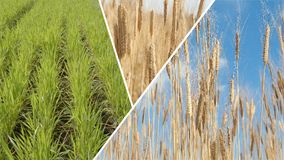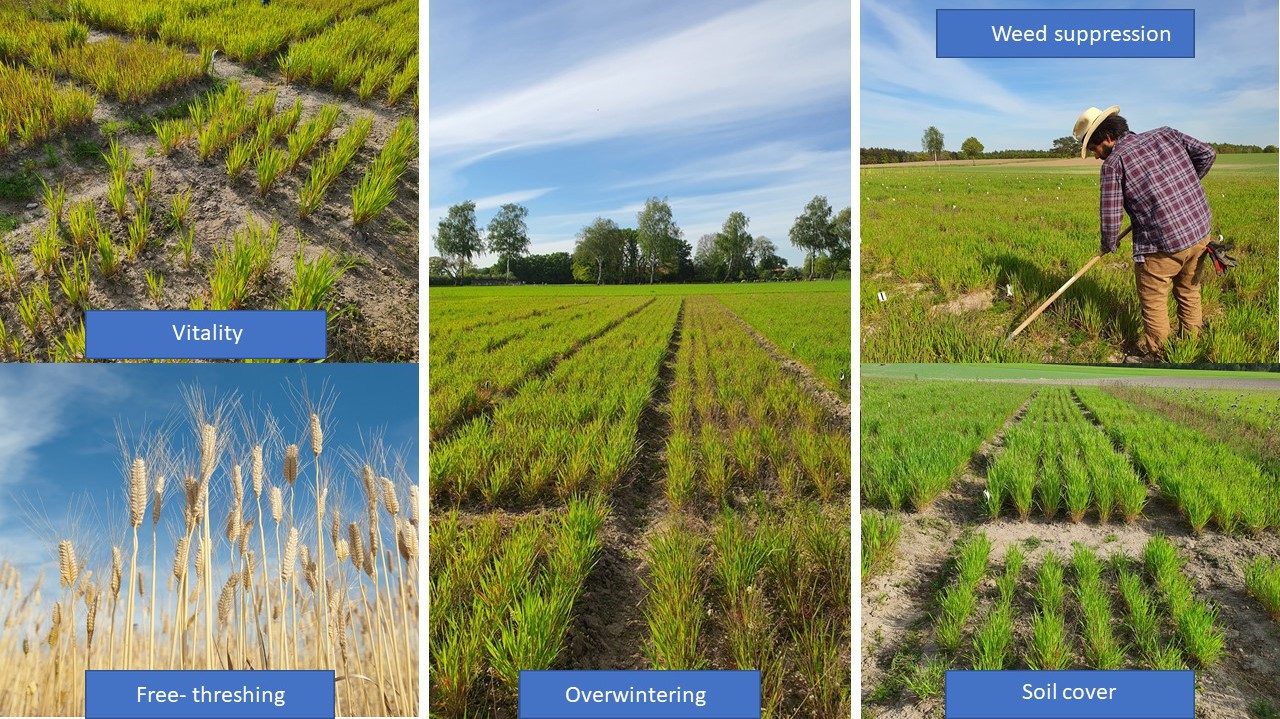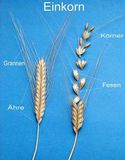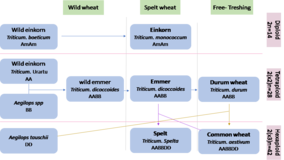Einkorn - A Fine Grain
Einkorn (Triticum monococcum L.) is a grain species with extraordinary characteristics formerly grown in mainland Europe. Gardeners took some special interest in Einkorn at the beginning of bio-dynamic farming, when they searched for cereal forms between wild grasses and modern cereals. Very little attention had been paid to breeding those forms. It was hoped that the older forms would show original characteristics which have been lost during the modern breeding process.
Einkorn Breeding at Cultivari gGmbH
Einkorn has special properties such as high carotenoid and protein content, and a special aromatic taste. At Cultivari we have taken on the challenge of preserving the special properties of einkorn and at the same time giving the plants a direction through classic crossing and selection. For example, we are working on increased yields and larger grain kernels for better baking quality. The experiences of farmers and bakers who use the varieties developed here are also incorporated into future development.
Ideally, einkorn varieties for organic farming have a very good winter hardiness, grow quickly in the spring after intensive planting, and produce a satisfactory yield with a high plant height shading unwanted weeds. Desirably, the awns should break off slightly during the threshing so that the grains can be removed from the combine harvester. A completely free-threshing einkorn, in which the husks fall off while threshing and remain on the field, would promote wide and easy use, but such einkorn forms are still a rarity and they still lack all the other properties mentioned above. Einkorn is naturally a very healthy plant; it is important to keep an eye on its health properties so that it remains the same in future varieties.
The yellow pigments are particularly important because they should not be lost during future breeding projects. In addition, the processing properties of the einkorn could be improved. However, this requires special test procedures to differentiate them according to varieties and breeding lines. As with wheat, the internationally used SDS sedimentation value and the Stirring Number or Falling Number can also be used for einkorn. A special microback test is also available.
In this way we try to make this unique grain have improved cultivation performance, so that it can play a larger role in the human food chain.
More than just a grain!
Einkorn is a modern name developed from a botanical classification. The ear of einkorn is very brittle, and it can easily be divided into single spikelets. Typically, in every spikelet one single kernel can be found that has developed from one single flower. Sometimes two flowers will produce two seeds on one spikelet. Typically, the two-kernel spikelet is known as "emmer" and developed later in the evolution of cereals. Emmer is more useful for pasta and is more closely related to durum wheat. When trying to distinguish between einkorn and emmer one must look at more than just the number of seeds per spikelet.
The intensive Yellow color of the flour is a very special characteristic of einkorn. Additionally, the color of the hulls varies are different from white through brown to black. Furthermore, there is a difference in hardness of hulls. The grain can be hulled or hulless after threshing. With a very simple cleaning process the hulless varieties can be used for further processing. If you notice the filigree of the shoots in its shining green stage, then you know right away that einkorn is not an ordinary grain. It is the most delicate of all cereals grown in Europe.
Relations between Cereal Species
Einkorn is one of the oldest species of grain known to humanity. Contrary to popular belief, einkorn is not a direct ancestor of wheat. To explain the relationship, take a look at this explanation:
Triticum boeticum (AmAm) and T. urartu (AA) are two well-known wild Triticum species, with diploid chromosome set. These two are separated by crossing barriers and have different plant morphologies [2]. T. boeticum, also known as wild einkorn, was domesticated by repeated cultivation to produce diploid einkorn (T. monococcum). It comes from the region of the Karacada Volcano in the southeast of today's Turkey [1.4]. The name einkorn comes from the appearance of the plant, since only one grain is formed per spikelet. T. urartu was not domesticated like T. boeticum, but it did play an important role in the development of modern cereals such as durum and common wheat [7,3,6].
Project Optimaleinkorn (2019-2022)
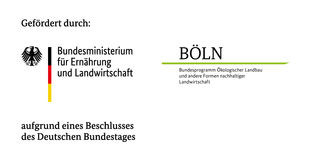

In October 2019, Cultivari started a new project under the name " Optimaleinkorn". The project focuses on the optimization of einkorn in various properties to make it more interesting for growers and processors. As a crop it is of little importance for cultivation right now, but it harbours great potential for organic farming.
In order to be able to improve the practical application of einkorn as well, we have acquired the Bohlsener-Mühle and Spielberger-Mühle as cooperation partners in the field of baked goods processing, as well as Erdmann Hauser as a specialist in processing cereals.
Many parameters such as testing and improving weed competition, stability, yield, processing stability for baked goods and use for cooked cereals will be considered in this project. In addition to the above-mentioned parameters, importance should also be attached to the valuable characteristics of einkorn. This includes, on the one hand, the low proportion of ATIs (?-Amylase-Trypsin-Inhibitors) that play a role in wheat intolerance (non-celiac disease) [5]. This is considered when testing and breeding the single-grain varieties so that the new varieties remain well tolerated. On the other hand, Einkorn has a relatively high carotenoid content compared to wheat, this characteristic should also be retained in order to create a nutritionally valuable food. This is made possible by the 3-year funding from the BMEL / BÖLN and the friendly support of the software G-M Foundation.
The development of the micro-baking test for einkorn is based on the micro-baking test for wheat by Cultivari. The recipe and the baking process have been optimized for einkorn. Here the recipe "without sugar and fat", "only with sugar" and "with fat and sugar" was varied. Different resting and fermentation times as well as fermentation temperatures were compared. The methods of the backtest are briefly outlined below.
|
Normal Backtest |
Extended fermentation time |
Langzeitführung Backtest |
|||
|
Rest time |
without |
Rest time |
without |
Rest time |
23h / 4°C |
|
Fermentation temperature |
29°C |
Fermentation temperature |
22°C |
Fermentation temperature |
30°C |
|
Fermentation time |
60 min |
Fermentation time |
90 min |
Fermentation time |
45 min |
|
Baking temperature |
190°C |
Baking temperature |
190°C |
Baking temperature |
190°C |
|
Baking time |
17 min |
Baking time |
17 min |
Baking time |
17 min |
The recipe for the baking test consists of 20 g of flour plus 1% fat, 1% sugar, 2.5% yeast, 3% salt, and an individually determined amount of water. The Microdoughlab is used to determine the amount of water for the recipe. The baking test is carried out in baking machines from Unold company.
Based on the results of the baking tests, the decision was made to use the long-term baking test with added sugar and fat for the series tests of the samples in 2020. This showed better results in terms of volume and poring compared to the "extended fermentation time" and "normal" backtest. In addition, the current study situation shows that an extended resting time leads to better wheat tolerance [23].
Between the three categories "Without sugar and fat", "Only with sugar" and "With sugar and fat", the variant with sugar and fat was chosen, as this comes closest to practical use and has no negative effects on the baking result.
1.Cooper, R. (2015): Re-discovering ancient wheat varieties as functional foods. Journal of Traditional and Complementary Medicine, 5:3, 138-143.
2.Dorofeev, V. F.; Filatenko, A. A.; Migushova, E. F.; Udaczin, R. A.; Jakubziner, M. M. (1979) Wheat. Flora of Cultivated Plants, 1, 346.
3.Dvorak, J.; Deal, K. R.; Luo, M. C.; You, F. M.; Von Borstel, K.; Dehghani, H. (2012): The origin of spelt and free-threshing hexaploid wheat. Journal of Heredity, 103:3, 426-441.
4.Harlan,J.R.(1981): The early history of wheat: Earliest traces to the sack of Rome. IN: EVANS,L.T. & W.J.PEACOCK : Wheat Science Today and Tomorrow. Cambridge University Press, p 1-19.
5.Heun,M.; Schafer-Pregl,R.; Klawan,D.; Castagna,R.; Accerbi,M.; Borghi,B.; Salamini,F.(1997): Site of einkorn wheat domestication identified by DNA fingerprinting. Science 278, 1312-1314.
6.Kling C.I.(2005): Nutzung genetischer Ressourcen für die Evaluierung von Einkorn und Emmer im Hinblick auf deren Einsatz in der Praxis. IN: VERN [Hrsg.]: On-farm-Erhaltung genetischer Ressourcen von Getreide und Ölpflanzen, ISBN 3-00-016314-X, p17-26.
7.Ziegler, J. U.; Steiner, D.; Longin, F. H.; Würschum, T.; Schweiggert, R. M.; Carle, R. (2016): Wheat and the irritable bowel syndrome – FODMAP levels of modern and ancient species and their retention during bread making. J. Funct. Foods. (25) 257-266. dx.doi.org/10.1016/j.jff.2016.05.019
